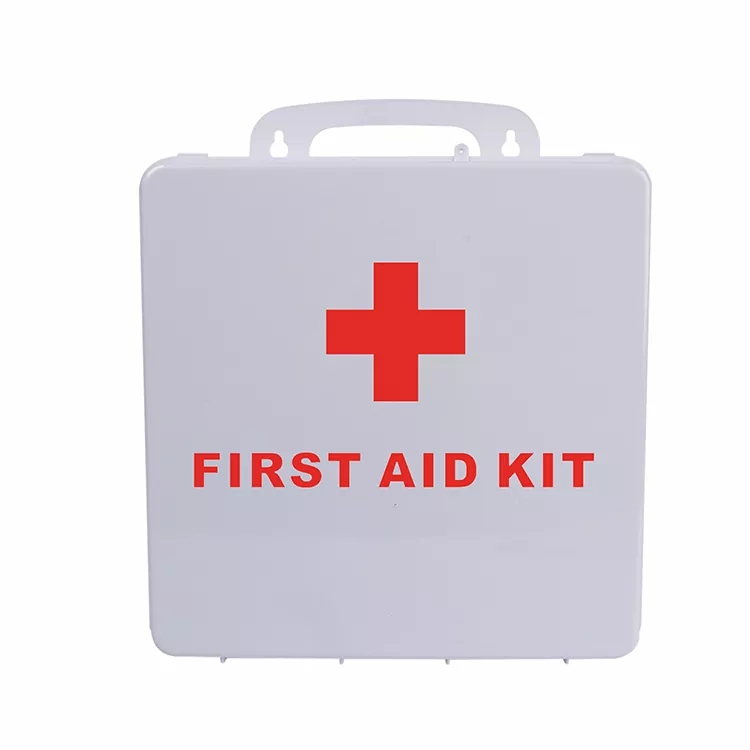The use of Home and Industrial First Aid Kit?
A home and industrial first aid kit is a collection of medical supplies and equipment that are used to provide immediate care and treatment for injuries and illnesses. These kits are essential for both home use and industrial environments where accidents and injuries may occur. While the specific contents may vary based on individual needs and regulations, here are some common items found in a home and industrial first aid kit:
 Bandages: Assorted adhesive bandages of different sizes, including sterile gauze pads and adhesive tape.
Bandages: Assorted adhesive bandages of different sizes, including sterile gauze pads and adhesive tape.
Antiseptic solutions: Antiseptic wipes, alcohol pads, hydrogen peroxide, or antiseptic solutions to clean wounds and prevent infection.
Disposable gloves: Latex, nitrile, or vinyl gloves to protect against contamination and maintain hygiene while providing first aid.
Scissors and tweezers: To cut clothing, tape, or bandages, and to remove splinters or foreign objects from the skin.
Sterile dressings: Sterile eye pads, non-adhesive dressings, and trauma dressings for larger wounds or injuries.
Cold packs: Instant cold packs or reusable cold compresses to reduce swelling and alleviate pain.
Thermometer: A digital thermometer to measure body temperature accurately.
CPR mask: A pocket mask or face shield for administering CPR (cardiopulmonary resuscitation) safely.
Medications: A selection of over-the-counter medications such as pain relievers (e.g., acetaminophen, ibuprofen), antihistamines, and antacids.
Tweezers: Fine-pointed tweezers for removing splinters or other small objects.
Burn ointment: Topical ointments or gels for treating minor burns and soothing the affected area.
First aid manual: A comprehensive guide or manual that provides instructions on how to administer first aid in various situations.
In addition to these basic supplies, an industrial first aid kit may include specialized items such as:
Eye wash solution: Saline solution or sterile water for rinsing and flushing the eyes in case of chemical exposure or foreign particles.
Splinting materials: Various types of splints for immobilizing fractures or sprains.
Tourniquet: A device for applying pressure to control severe bleeding in emergency situations.
Emergency blankets: Lightweight, heat-reflective blankets to provide warmth and comfort during emergencies or shock situations.
Resuscitation equipment: Advanced airway devices, bag-valve masks, or automated external defibrillators (AEDs) for more extensive emergency care.
It's important to periodically check and replenish your first aid kit to ensure that all supplies are up to date, unexpired, and in good condition. Additionally, consider taking a first aid and CPR course to gain the necessary knowledge and skills to effectively respond to emergencies.

Antiseptic solutions: Antiseptic wipes, alcohol pads, hydrogen peroxide, or antiseptic solutions to clean wounds and prevent infection.
Disposable gloves: Latex, nitrile, or vinyl gloves to protect against contamination and maintain hygiene while providing first aid.
Scissors and tweezers: To cut clothing, tape, or bandages, and to remove splinters or foreign objects from the skin.
Sterile dressings: Sterile eye pads, non-adhesive dressings, and trauma dressings for larger wounds or injuries.
Cold packs: Instant cold packs or reusable cold compresses to reduce swelling and alleviate pain.
Thermometer: A digital thermometer to measure body temperature accurately.
CPR mask: A pocket mask or face shield for administering CPR (cardiopulmonary resuscitation) safely.
Medications: A selection of over-the-counter medications such as pain relievers (e.g., acetaminophen, ibuprofen), antihistamines, and antacids.
Tweezers: Fine-pointed tweezers for removing splinters or other small objects.
Burn ointment: Topical ointments or gels for treating minor burns and soothing the affected area.
First aid manual: A comprehensive guide or manual that provides instructions on how to administer first aid in various situations.
In addition to these basic supplies, an industrial first aid kit may include specialized items such as:
Eye wash solution: Saline solution or sterile water for rinsing and flushing the eyes in case of chemical exposure or foreign particles.
Splinting materials: Various types of splints for immobilizing fractures or sprains.
Tourniquet: A device for applying pressure to control severe bleeding in emergency situations.
Emergency blankets: Lightweight, heat-reflective blankets to provide warmth and comfort during emergencies or shock situations.
Resuscitation equipment: Advanced airway devices, bag-valve masks, or automated external defibrillators (AEDs) for more extensive emergency care.
It's important to periodically check and replenish your first aid kit to ensure that all supplies are up to date, unexpired, and in good condition. Additionally, consider taking a first aid and CPR course to gain the necessary knowledge and skills to effectively respond to emergencies.



